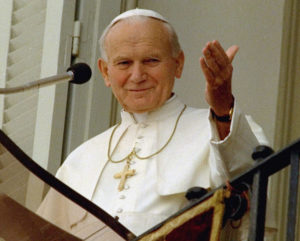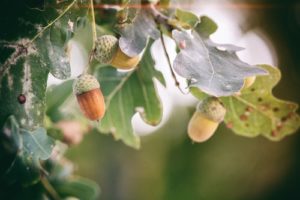
40th Anniversary of the First Wednesday Audience of St. John Paul II Revealing the Theology of the Body
August 30, 2019
 On September 5, 2019, we will commemorate the fortieth anniversary of one of the greatest gifts of St. John Paul II’s extraordinary papacy: his very first Wednesday (General) Audience giving light and life to Theology of the Body. Think about this:
On September 5, 2019, we will commemorate the fortieth anniversary of one of the greatest gifts of St. John Paul II’s extraordinary papacy: his very first Wednesday (General) Audience giving light and life to Theology of the Body. Think about this:
- Who could have predicted that this Wednesday Audience would develop into 129 such sessions, and ultimately blossom into what we now know as “Man and Woman He Created Them: A Theology of the Body?”
- Who would have foreseen that 40 years later, (a number with Biblical significance of change for God’s people) Ruah Woods would emerge as the world’s first lay apostolate to translate these Wednesday Audiences into a K-12 Catholic school curricula already reaching thousands upon thousands of students, teachers and parents? Praise God for His mercy and generosity!
Some might be tempted to think of TOB as a “new teaching.” Nothing was further from the mind of St. John Paul II. He saw everything he submitted in continuity with all that the Church has proposed for us over the centuries.
Growing in Wisdom
One of Saint John Paul II’s most influential teachers, the soon-to-be-canonized Blessed John Henry Newman, taught that Catholic doctrine can and does develop over time. Newman’s ideas revolutionized our and Saint John Paul II’s understanding of how God continues to speak to us here and now through the dynamic, living Word of God. Newman, who after St. Augustine was the most quoted theologian of Vatican II, taught that in the historical dimension, God has in the person of Jesus Christ definitively revealed everything he wishes to teach us, and that there will be no further revelations other than the person of Jesus Christ (Hebrews 1:1; DV 28, CCC 65). But Newman’s original contribution to our understanding, and what St. John Paul II clearly echoed in his very first Wednesday audience, was that the fullness of that self-gift of God’s revelation unfolds and matures over time.
Continual Flowering
Saint John Paul II’s anthropology of the human person, rooted in Genesis, is anticipated in Blessed John Henry Newman’s famous and beautiful analogy of the Word of God as a tree (Development of Doctrine, 8). God’s self-revelation of his loving design for happiness, his logos, is embodied in the person of Jesus Christ. But that logos is like the design of an acorn, that will in time become a beautiful oak tree. The mature tree is organically related back to its source, the seed, which prefigures the tree. Similarly, under the guidance of the Holy Spirit, the Church’s Magisterium continues to listen attentively to the Sacred Scriptures and Sacred Tradition, and over time, to derive from them concepts that were present in the bible, but unstated, such as the Holy Trinity.
This concept of doctrinal development is also seen in JP II’s first Wednesday audience of September 5, 1979. He looks at the nature of marriage through the lens of the very Words of Christ in Matthew 19 and Mark 10. Jesus is responding to the Pharisee’s questions about Jesus’ authority to pronounce on the institution of marriage. In both texts, Jesus twice refers to “in the beginning.”
This 2-fold occurrence becomes the departure point of what will become St. John Paul’s Theology of the Body: “what precisely did Christ mean by this expression, ‘from the beginning?’”
 Finding our Voice
Finding our Voice
JP II envisions Theology of the Body as an inherently evangelizing and missionary outreach to a confused and broken world. He does this by insisting that we take the personal situation of Christ’s questioners, his “interlocutors,” seriously. They seek to entrap Christ into a legal and political line of questioning. Jesus simply rejects this — and so should we. But JP II, with equal force, wishes us to see that Christ did not locate his authority in himself.
The integral “move” is St. John Paul’s reminder that Christ twice uses the phrase “from the beginning.” He wishes to remind us that his teaching is not his own.
“He wishes to induce his interlocutors to reflect on the way in which “male and female” were formed in the mystery of creation, in order to understand correctly the normative sense of the words of Genesis. This is no less valid for the people of today than for those of that time. Therefore, in the present study, we must put ourselves in the position of Christ’s interlocutors today.”
Just as the overture of a symphony conveys the sense of the music, so it is with John Paul II’s first prophetic Wednesday Audience. Let us thank God that this 40th Anniversary of the “Overture of the Theology of the Body” is an invitation for us to place ourselves in conversation with Christ so we may return to the life-giving “beginning” to which He so passionately appeals.
Written by, Fr. Thomas Wray
Chaplain, Ruah Woods Press
Share